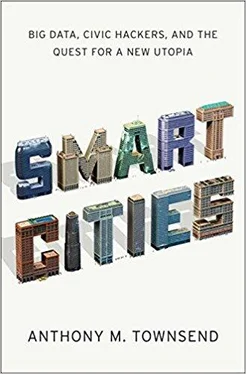We need to build a systematic evaluation of social sustainability into the planning of new smart-city services. Once we have a sense of the risks, mitigating measures can be designed. In most democracies today (though only in a handful of places in America), there are regulations in place to ensure that plans for new housing, roads, and parks explicitly address the most vulnerable members of society. Technology projects in smart cities must be held accountable to the same standard.
Do Sound Urban Science
We have seen how the introduction of new scientific ideas about cities and data-driven approaches to urban management and planning often bring unwelcome baggage and unintended negative consequences. As I set out to write this book in 2010, a coterie of “hard” scientists—physicists and mathematicians—at the prestigious Santa Fe Institute proclaimed the launch of a new science of cities from their desert retreat. That December, a cover story for the New York Times Magazine breathlessly reported on empirical studies of urban growth conducted by Geoffrey West and his colleague Luis Bettencourt. (Ominously, perhaps, the article was written by Jonah Lehrer, who would later resign from his position as staff writer at the New Yorker in 2012 following accusation of plagiarism for several articles—not including this one). Homing in on the grandiloquent West as the new champion of rational study of the city, the headline boldly pronounced “A Physicist Solves the City.” Despite Lehrer s disparaging claims that “West considers urban theory to be a field without principles, comparing it to physics before Kepler pioneered the laws of planetary motion in the 17th century,” and despite any obvious implications for actual policy making or planning, theirs was a significant and welcome addition to the field of urban studies. The big breakthrough, gleaned from data on income, infrastructure, and patents for new innovations, was that as cities grew, they became more productive. A city of 2 million didn’t just have twice as much earnings and patents as one with only one million residents, it had double plus 15 percent—a divine gratuity! And that held not just for the good, but the bad as well. Crime and HIV infections were also subject to this superlinear scaling. The process worked in reverse too. Tell West the size of a city, and he could predict its key characteristics. West dazzled audiences around the world with these seemingly universal truths. Yet as my writing came to an end late in 2012, these claims had begun to come under intense scrutiny.
The first salvo came from one of West’s and Bettencourt’s own colleagues, Carnegie Mellon University statistician Cosma Shalizi, who is himself listed as “external professor” on the Santa Fe Institute website. Shalizi tried to replicate West’s and Bettencourt’s analysis, and what he discovered was disconcerting for those who had bought into West’s elegant theory. In a paper posted to the electronic prepress archive arXiv, Shalizi argued that West and Bettencourt had only looked at city-wide figures and not per capita values. “The impressive appearance of scaling displayed,” he wrote, “is largely an aggregation artifact, arising from looking at extensive (city-wide) variables rather than intensive (per-capita) ones.” Michael Batty, the urban-simulation expert, says that while the scaling effect is still detectable when one converts extensive variables to intensive ones (simply by normalizing, or dividing by population), it is much noisier, or less clear. In general, that is an expected and not immediately disconcerting effect.54 But what Shalizi also showed was that other explanations could fit the scaling data just as well as the model used by the Santa Fe team. He constructed his own model based on conventional, century-old notions from economic geography that explain why highly productive, specialized businesses tend to cluster in cities. Controlling for just four such industries, he found, ‘“screens off’ the effects of city size on per-capita production.” He continued, “there is a weak tendency for per-capita output and income to rise with population, though the relationship is simply too loose to qualify as a scaling law.... Qualitatively, this is what one would expect from well-established findings of economic geography.”
While Shalizi’s paper was ultimately rejected for publication in the Proceedings of the National Academy of Sciences (for unknown reasons, as the peer reviews are not made public), the universality of superlinear urban scaling is being called into question by at least one other study. Elsa Arcaute, a researcher at Batty’s group in London, has attempted to replicate the results using ward-level data for England and Wales, a much richer level of detail than West and Bettencourt, who worked with units of entire metropolitan areas. What she found is that super-linear scaling appears to occur for some variables, but only if one limits the definition of a city to its dense core. Expand the analysis to include outlying areas of a region and the scaling relationship breaks down. Batty points out that superlinear scaling is also subject to the way different indicators are measured differently in each country, and the distorting effects of policy on land use and migration patterns.35 The United Kingdom, for instance, has long actively sought to decentralize population and growth from London, which may be one reason why scaling is less evident there. And cities in Europe tend to run into one another, whereas in the United States (where the data fit the Santa Fe model best), there are wide-open spaces separating them. So while superlinear scaling in cities can be found in some places, it clearly isn’t as universal as West has argued. The only universal thing about urban scaling may be just how easily it yields to our interventions. “[T]he elegant hypothesis of power-law scaling marked a step forward in our understanding of cities,” Shalizi concludes. “But it is now time to leave it behind.”56 Urban scaling isn’t quite cold fusion, but it doesn’t seem to be the quantum theory of cities either.
This is an important cautionary tale, for the convergence of urbanization and ubiquity will drive demand for rigorous empirical research on cities. In 2012, in New York City alone, three new university departments were established—at Columbia University, New York University/Polytech, and Cornell University—with an explicit focus on applied urban science. These groups, along with others recently launched in London, Chicago, Zurich, and Singapore, will mine the blooming data exhaust of smart cities and deploy new sensory instruments. They will each become what the physicist who leads NYU’s effort, Steve Koonin, calls an “urban observatory”—latter-day Outlook Towers where researchers build vast new mirror worlds in search of Gelernter’s elusive topsight. The scale and complexity of cities is drawing in bright minds from physics, mathematics, and computer science, just as it intrigued West. But what Shalizi’s alternative explanation and Arcaute’s detailed geographical analysis tell us is that the old theories are at least as good at explaining what’s going on in cities as the new ones. If this new urban science dismisses what has come before it, and fails to ground itself in what has already been discovered, it runs the risk of being at best wrong, and at worst—as it seems West’s claims have become—deeply misleading.
As much as West’s assertions may have filled our heads with certainty about unconfirmed notions on the nature of urbanization, the collateral damage of these fables so far is probably inconsequential. Because, in the end, they weren’t of much practical use. Intellectually, the idea that cities become more efficient and productive as they grow was fascinating. But what did it mean in terms of policy? That growth was the only sound option? That flew in the face of fifty years of rather sound city- planning practice that sought to manage growth and curb the excesses of unchecked expansion (albeit not always successfully or without unintended consequences). And basic questions about the work’s implications remained. How did the process play out? How big could or should cities get? West didn’t have any answers for that either. “It’s totally unclear if there is a maximum size for cities,” he told an audience in New York in 2011. It all seems so disconnected with what has become obvious —trying to grow our way out of ecological collapse is a risky gamble. Constraint, which is what most efforts to promote sustainability really mean, isn’t the solution either. The planning vanguard is now embracing the reality of severe climate shocks, and is trying to develop ways of making cities more resilient and able to absorb them. Adaptation, not growth, seems to be how well get through the twenty-first century.
Читать дальше












